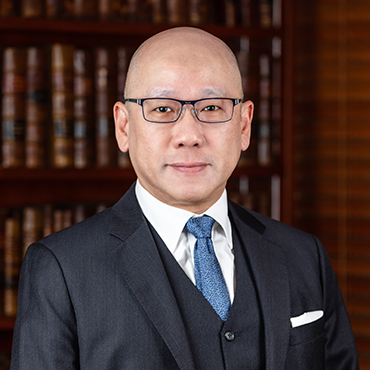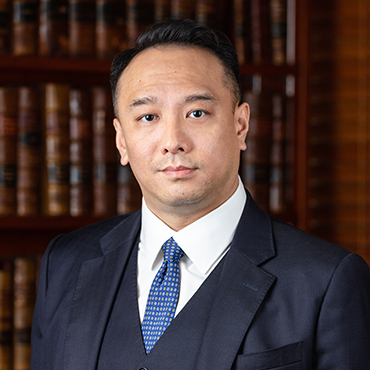LKYI v GJS (Personal representative of KO, deceased) (Financial provision claimed by de facto wife) [2024] 5 HKC 758, [2024] HKFC 145 (Robert Pang SC, Eric Leung)
Robert Pang SC and Eric Leung represented the applicant in LKYI v GJS (Personal representative of KO, deceased) (Financial provision claimed by de facto wife) [2024] 5 HKC 758, [2024] HKFC 145.
The applicant was the de facto wife of the deceased. The deceased founded and operated two companies, one that ran a plane ticketing and hotel booking service, and a licenced insurance broker. Before the deceased’s demise, the applicant had cohabited with the deceased for about ten years. They had a daughter together. The estate had a net value of about $166.3 million, comprising cash, listed shares and interests in landed properties including one which was occupied by the applicant and the daughter as their residence, but excluding the value of the companies. Under s 4(5) of the Intestate’s Estates Ordinance (Cap 73), the deceased’s residuary estate shall be held on statutory trusts for the daughter, who was the sole known beneficiary of the estate. Therefore, no financial provision had been made to the applicant out of the estate. The applicant thus applied for reasonable financial provision under the Inheritance (Provisions for Family and Dependents) Ordinance (Cap 481) (IPFDO). Section 5(7) of the IPFDO provided that in evaluating the matters set out in s 5, the Court shall take into account ‘the facts as known to the court as at the date of the hearing’. Since the deceased’s demise, the applicant had not applied for letters of administration of the estate, because she did not want to be in conflict with the estate due to her claim for financial provision. The respondent, who was the deceased’s nephew and the eldest male descendant of the deceased’s extended family, was appointed to represent the estate solely for the purpose of the present proceedings.
Held, ordering that upon the applicant’s undertaking to the Court and the Estate that she shall be responsible for settling by her own funds all the expenses for her maintenance and she shall not seek or allow the Companies and/or the Estate to pay such expenses or any part thereof without full reimbursement by her promptly, (1) the personal representative of the Estate shall transfer from the Estate 50% of the legal and beneficial title and ownership of the Stubbs Road Property free of all encumbrances to the applicant at nil consideration and (2) the personal representative shall pay to the applicant from the estate a lump sum of $13,612,000, that:
(1) The precise meaning of ‘maintenance’ must depend on all the facts and circumstances of the particular case. ‘Maintenance’ included payment which enabled the applicant to pay for the costs of her living directly or indirectly in the future at the standard of living appropriate to her. It was not limited to a subsistence level, nor extend to a payment to support an extravagant life or a standard desirable for general well-being. It was to provide income for maintenance of the applicant. It was not to confer capital nor did it mean to provide legacies for the applicant. The limitation to provision for maintenance represented a deliberate legislative choice and demonstrated the significance attached by the law to testamentary freedom. The legislation was not designed to introduce a general power to re-write the testator’s will or the deceased’s choice to be governed by the law of intestacy. Whilst the statutory power was not to confer capital or legacies, the maintenance that could be awarded was not limited to periodical payment. In some cases, it was more appropriate and more convenient for other beneficiaries and for executors if income was provided by way of a lump sum from which both income and capital could be drawn over the years. Payment to meet an applicant’s housing needs could be part of the maintenance. The claim for maintenance was not a moral claim. That the applicant was in necessitous circumstances per se was not a sufficient ground for an award. There should be a single assessment of what reasonable provision should be made in all the circumstances of the case. The judge was not required to fix some hypothetical standard of reasonable provision and then either add to it, or discount from it, by percentage points or otherwise, for variable factors. Re Coventry, deceased [1980] 1 Ch 461; Re Dennis deceased [1981] 2 All ER 140; Re Duranceau [1952] 3 DLR 714; LZX v WYL (Provision: family and dependants) [2012] 5 HKLRD 29 ; [2012] HKFLR 270; Tam Mei Kam v HSBC International Trustee Ltd [2017] HKCU 348, (CACV 181/2016, Lam VP, Cheung and Kwan JJA, 10 February 2017, unreported); Ilott v Mitson (No 2) [2018] AC 545; and Cameron v Treasury Solicitor [1996] 2 FLR 716 considered (para 30).
(2) The nature and quality of life that an applicant had accustomed to live with the deceased prior to his demise was part of the facts and circumstances that the court shall have regard to when considering a claim under the IPFDO people enjoyed a more comfortable life than others. Care should be given when the court had regard to the previous lifestyle of the applicant. This was not to be construed subjectively. The court’s statutory power to make reasonable financial provision ‘was an evaluative judgment based on objective considerations, not the subjective view of the applicant’. This applied to the consideration of the nature and quality of life previously enjoyed by the applicant, which was to be viewed objectively when assessing maintenance. Tam Mei Kam v HSBC International Trustee Ltd (above) applied. Re Christie, deceased (above) considered (para 37).
(3) Hong Kong had not adopted the English amendment which placed civil partners and cohabitees into the category of ‘surviving spouse’. There remained a clear statutory distinction on the standard of reasonable provision applied to a surviving spouse and other categories of applicants. It was wrong to associate the de facto wife status of the applicant (as a dependent under the IPFDO) with the entitlement of a de jure surviving wife in the assessment of reasonable maintenance. The applicant might have lived with the deceased as husband and wife, and were treated by the deceased’s relatives and friends as his wife. These were indicative of the closeness of their relationship. It remained the fact that they chose not to register their marriage formally. An attempt to draw a comparison with a de jure wife’s entitlement was liable to create confusion (para 67).
(4) Having considered all the relevant factors, $75,000 was found to be a reasonable provision for the applicant’s monthly maintenance (para 105).
(5) In relation to accommodation needs, the applicant’s proposal (that 50% interest in the property be transferred to her) was a better option. First, it was beneficial to the daughter and the applicant that they continue living together in the property. Secondly, the applicant would have security for her accommodation. Thirdly, the proposed value of $6.62 million to reflect the costs of accommodation was reasonable and not disputed. Fourthly, by transferring 40% interest in the property in lieu of part of the lump sum payment, the estate would not be compelled to sell landed properties to settle the lump sum maintenance award due to insufficient cash flow. Fifthly, holding the property as joint tenants may give an unbefitting windfall to the applicant in case she lived longer than the daughter. Sixthly, in the normal course of events, whether a property was held by the co-owners as joint tenants or tenants in common, the co-owners would have practical difficulties to sell or otherwise dispose of the property without consent of the other side. It was unlikely that the daughter would have lesser production if the property was held by them as joint tenants (para 114).
(6) Methods other than Duxbury calculation may be adopted in appropriate cases. Bespoke calculation appeared to have the benefit of flexibility to cater for special features in individual cases. An important condition for bespoke calculation was the correct identification of specific parameters and the figures to be adopted in these specific parameters. It was not prudent for the court to just pick a figure without supporting evidence. Often, expert evidence on these areas would assist the court. The Chan/Ogden Tables emerged to deal with the limitation of the multiplier-multiplicand method commonly used in personal injuries cases. The basis for awarding damages in tort cases and maintenance in matrimonial cases was different. Expert evidence on the underlying basis and differences of these methods would be of assistance to the court (paras 147-148).
(7) In the present case, the respondent suggested the bespoke calculation by using the Duxbury formula but replacing the parameter of life expectancy with a retirement age. The respondent also invited the court to consider using the Chan/Ogden Tables and the multiplier-multiplicand method. However, the respondent had not (a) suggested an appropriate retirement age and adduce evidence in support; (b) propose figures and/or multipliers to be used in the Chan/Ogden Tables or the multiplier-multiplicand method with supporting evidence; (c) raise with the Single Joint Expert the proposed method of ‘bespoke calculation’ and ascertain his view on whether, if so how, this would affect (not only mathematically) the Duxbury calculation; (d) give the Single Joint Expert an opportunity to respond to the respondent’s criticism on Duxbury calculation; or (e) give the Single Joint Expert an opportunity to comment on the other proposed methods. The Court did not have the assistance of expert evidence to assess whether using the methods proposed by the respondent was better than the Duxbury calculation in this case. It would not be prudent to adopt the proposed alternative methods. The Duxbury calculation was therefore adopted. The capitalised lump sum for a monthly maintenance of $75,000 from the notional trial date was $40,092,000 (paras 149-152).
[The above is excerpted from the headnote to the report in HKC.]



